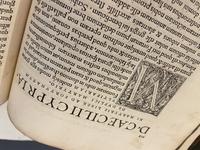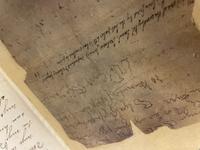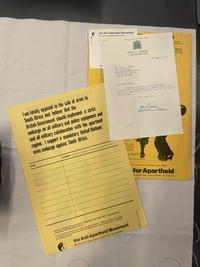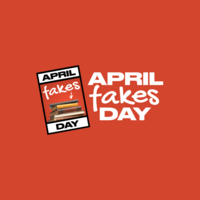Artefacts of a fabricated past
Dr Andrew Dunning, Curator of Medieval Manuscripts at The Bodleian, tells us about some forgeries in their collection.
The potential for forging the historical record has become far more evident in recent years, as powerful digital tools have made it easier to fabricate images and documents. This has made it more important than ever to preserve and study original historical artefacts, and to understand their full story.
The Bodleian holds a number of objects that most observers would now describe as forgeries, but is every fake a lie? Some were made with the intent to deceive, while others reflect collectors’ ideas of how to restore or complete a book. These artefacts are themselves part of the historical record. While they are not what they claim to be, they are important for what they reveal about the history of forgery and the reception of the works they imitate.
These forgeries range from ancient to modern, from literary to political, and from mundane to magnificent. Some were made for financial gain, some for personal prestige, and some for political ends. Experts have shown that they are not what they first seem through analysing style, materials, and historical context. Establishing the truth depends on verifiable physical evidence and provenance records that are openly accessible to the public.

‘Discovered in a very ancient library’
Erasmus’s De duplici martyrio: Vet D1 c.64, p. 508
Erasmus (died 1536) made his name as a humanist who ‘purged works from errors with more exact alertness’, as the title of his edition of the works of Cyprian, a third-century bishop of Carthage, advertises. Yet it includes On the Two Kinds of Martyrdom, supporting Erasmus’s view that martyrdom could be spiritual as well as physical. Scholars recognized stylistic clues pointing to Erasmus himself as its author in 1978.
Vet D1 c.64, pp. 508–9. Diui Caecilii Cypriani … opera iam quartum accuratiori uigilantia a mendis repurgata, per Des. Erasmum Roterod. Accessit liber eiusdem apprime pius ad Fortunatum De duplici martyrio, antehac nunquam excusus. (Basel, 1540; first edition, 1530).

‘From the supposed library of Masterre Wyllyamme Shakespeare’
William Henry Ireland’s Shakespeare signature: MS. Douce e. 8, fol. 1v
William Henry Ireland (1775–1835) curried favour with his father Samuel Ireland, an engraver, by giving him Shakespearean autographs to publish. He produced contracts, letters, marginalia, and even a new play, Vortigern. Francis Douce (1757–1834) noted that Ireland made his papers look genuine by also producing transcripts himself, ‘as it was impossible that any one except the impudent fabricator of the Shakespeare papers could read the hand writing of them’.
MS. Douce e. 8, fols. 1v–2r. William Henry Ireland, forged Shakespearean paper, ‘As I nowe fynde mye houre of syckness faste comynge onn’, dated 1616: with a transcript, also written by Ireland, 1795/6.

‘Some very singular heraldic blazoning’
Forged miniature opening a chronicle of France: MS. Fr. d. 4, fol. 8r
An owner of this Middle French chronicle in the seventeenth or eighteenth century had an opening miniature added to make the book appear more impressive. The stylistic and material differences are now obvious. The presentation scene, perhaps inspired by the scribe’s genuine signature at the end of the volume, may have aimed to disguise the book as a valuable copy given to King Philip VI of France (1293–1350).
MS. Fr. d. 4, fol. 8r. Chronicle of France from creation to 1339 by a monk of St-Denis, copied by ‘Droet’, 1400 × 1450. With a forged miniature, seventeenth or eighteenth century.

‘Decorated with birds, beasts, fishes, insects, and nondescripts’
Forged miniature in the Hours of Anne of Bohemia: MS. Lat. liturg. f. 3, fol. 65v
Anne of Bohemia (1366–1394) was thought to have brought this book with her to England in 1381 before she married Richard II, until art historians showed that the miniature of their marriage is a modern addition. This added scene shows how understanding of medieval art advanced in the nineteenth century. The catalogue of the 1887 sale where the Bodleian bought the book did not use it as a selling point.
MS. Lat. liturg. f. 3, fols. 65v–66r. Hours of ‘Anne of Bohemia’, Flanders, 1360s; the miniature on fol. 65v is a forgery, 1850 × 1887.

‘It is a very dirty smear.’
Petitions circulated under the Anti-Apartheid Movement: MSS. AAM 1511
In the final week of collecting signatures in a campaign against arms supplies to South Africa, the Anti-Apartheid Movement discovered modified versions of the petition in circulation, with the line ‘I reject western imperialist oppression of the poeple of Southern Africa’ and calling on the West to ‘join the Communist bloc’. Abdul Minty, the movement’s secretary, noted that they ‘make us look irresponsible and hard-line Left-wing.’
MSS. AAM 1511. Petitions forged by the South African Embassy using a genuine campaign of the Anti-Apartheid Movement, March 1977.
References
Erasmus’s De duplici martyrio: Vet D1 c.64, p. 508
Anthony Grafton, Forgers and Critics: Creativity and Duplicity in Western Scholarship, new edition (Princeton, NJ: Princeton University Press, 2019), 44–45, https://doi.org/10.1515/9780691192000.
S. Seidel Menchi, ‘Un’opera misconosciuta di Erasmo? II trattato pseudo-ciprianico De duplici martyrio’, Rivista storica italiana 90 (1978): 709—43.
William Henry Ireland’s Shakespeare signature: MS. Douce e. 8, fol. 1v
Paul Baines, ‘Ireland, William Henry (1775–1835), literary forger and writer’, Oxford Dictionary of National Biography (Oxford: Oxford University Press, 2004), https://doi.org/10.1093/ref:odnb/14451>.
Tom Lockwood, ‘Manuscript, Print and the Authentic Shakespeare: The Ireland Forgeries Again’, in Editing Shakespeare, ed. Peter Holland, Shakespeare Survey 59 (Cambridge: Cambridge University Press, 2006), 108–23, https://doi.org/10.1017/CCOL0521868386.009.
Forged miniature in the Hours of Anne of Bohemia: MS. Lat. liturg. f. 3, fol. 65v
Catalogue of the choice library of the late William Brice, Esq. of Bristol … which will be sold by auction, by Messrs. Sotheby, Wilkinson & Hodge (London: Dryden Press, 1887), no. 133, https://hdl.handle.net/2027/hvd.hnmrqi?urlappend=%3Bseq=646.
Lucy Freeman Sandler, Gothic Manuscripts 1285–1385 (London: Miller, 1986), 1:54.
Petitions circulated under the Anti-Apartheid Movement: MSS. AAM 1511
House of Commons, First report from the Foreign Affairs Committee. Session 1983–84. The abuse of diplomatic immunities and privileges, HC 127 (London: HM Stationary Office, 1984), 66.
Martin Walker, ‘Anti-Apartheid finds forgeries’, The Guardian, 14 March 1977, 1.



